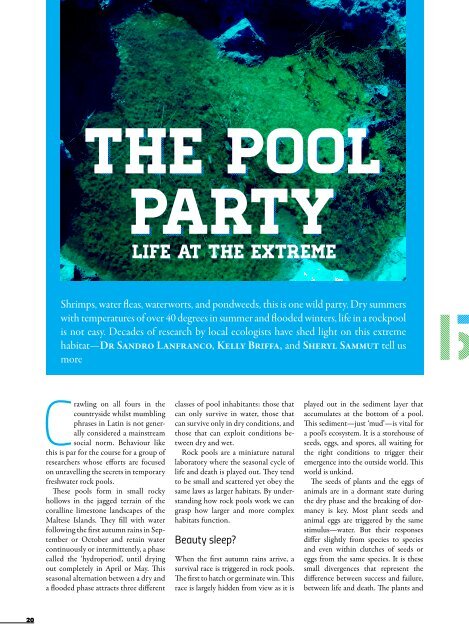You also want an ePaper? Increase the reach of your titles
YUMPU automatically turns print PDFs into web optimized ePapers that Google loves.
The Pool<br />
Party<br />
life at the extreme<br />
Shrimps, water fleas, waterworts, and pondweeds, this is one wild party. Dry summers<br />
with temperatures of over 40 degrees in summer and flooded winters, life in a rockpool<br />
is not easy. Decades of research by local ecologists have shed light on this extreme<br />
habitat—Dr Sandro Lanfranco, Kelly Briffa, and Sheryl Sammut tell us<br />
more<br />
BB<br />
Crawling on all fours in the<br />
countryside whilst mumbling<br />
phrases in Latin is not generally<br />
considered a mainstream<br />
social norm. Behaviour like<br />
this is par for the course for a group of<br />
researchers whose efforts are focused<br />
on unravelling the secrets in temporary<br />
freshwater rock pools.<br />
These pools form in small rocky<br />
hollows in the jagged terrain of the<br />
coralline limestone landscapes of the<br />
Maltese Islands. They fill with water<br />
following the first autumn rains in September<br />
or October and retain water<br />
continuously or intermittently, a phase<br />
called the ‘hydroperiod’, until drying<br />
out completely in April or May. This<br />
seasonal alternation between a dry and<br />
a flooded phase attracts three different<br />
classes of pool inhabitants: those that<br />
can only survive in water, those that<br />
can survive only in dry conditions, and<br />
those that can exploit conditions between<br />
dry and wet.<br />
Rock pools are a miniature natural<br />
laboratory where the seasonal cycle of<br />
life and death is played out. They tend<br />
to be small and scattered yet obey the<br />
same laws as larger habitats. By understanding<br />
how rock pools work we can<br />
grasp how larger and more complex<br />
habitats function.<br />
Beauty sleep?<br />
When the first autumn rains arrive, a<br />
survival race is triggered in rock pools.<br />
The first to hatch or germinate win. This<br />
race is largely hidden from view as it is<br />
played out in the sediment layer that<br />
accumulates at the bottom of a pool.<br />
This sediment—just ‘mud’—is vital for<br />
a pool’s ecosystem. It is a storehouse of<br />
seeds, eggs, and spores, all waiting for<br />
the right conditions to trigger their<br />
emergence into the outside world. This<br />
world is unkind.<br />
The seeds of plants and the eggs of<br />
animals are in a dormant state during<br />
the dry phase and the breaking of dormancy<br />
is key. Most plant seeds and<br />
animal eggs are triggered by the same<br />
stimulus—water. But their responses<br />
differ slightly from species to species<br />
and even within clutches of seeds or<br />
eggs from the same species. It is these<br />
small divergences that represent the<br />
difference between success and failure,<br />
between life and death. The plants and<br />
20


